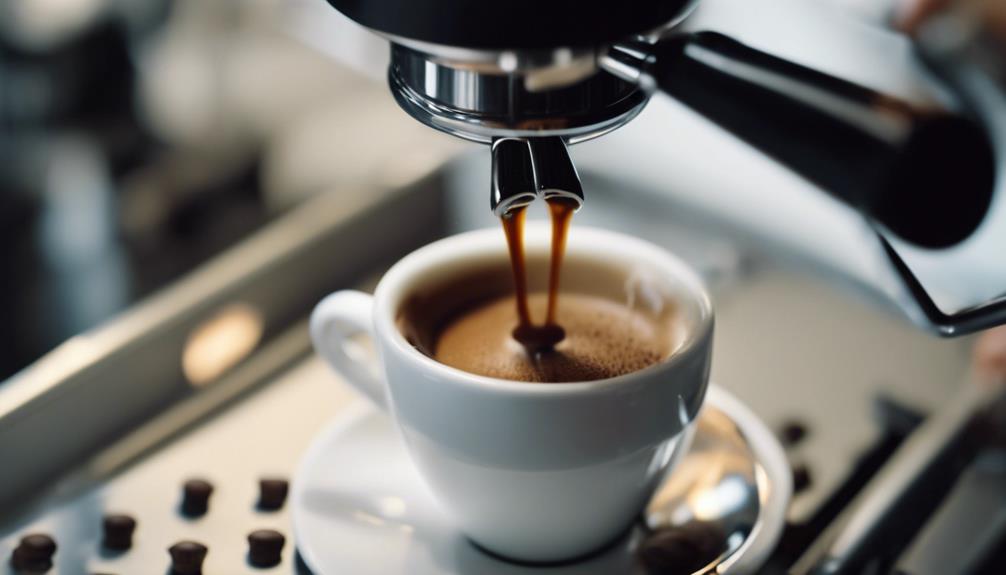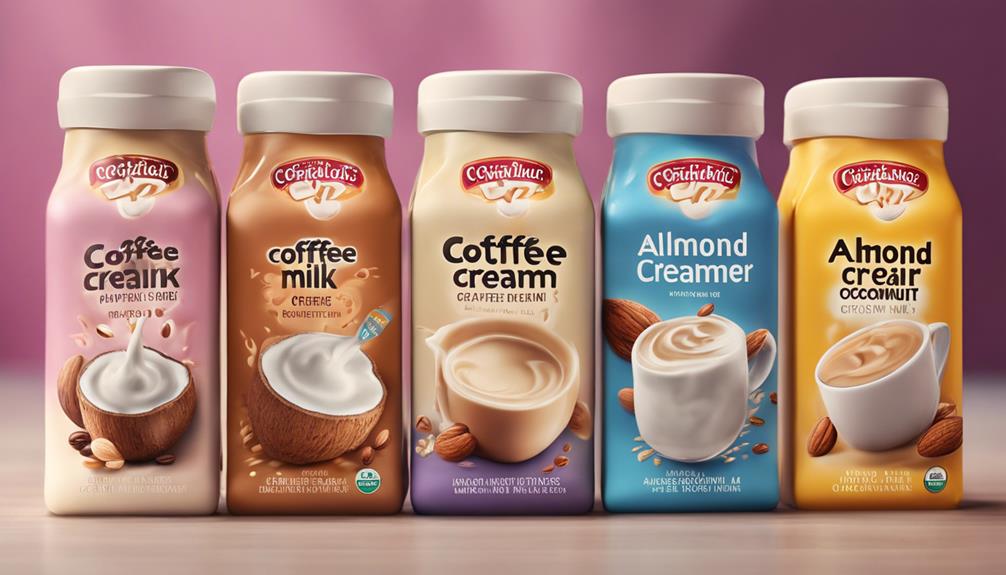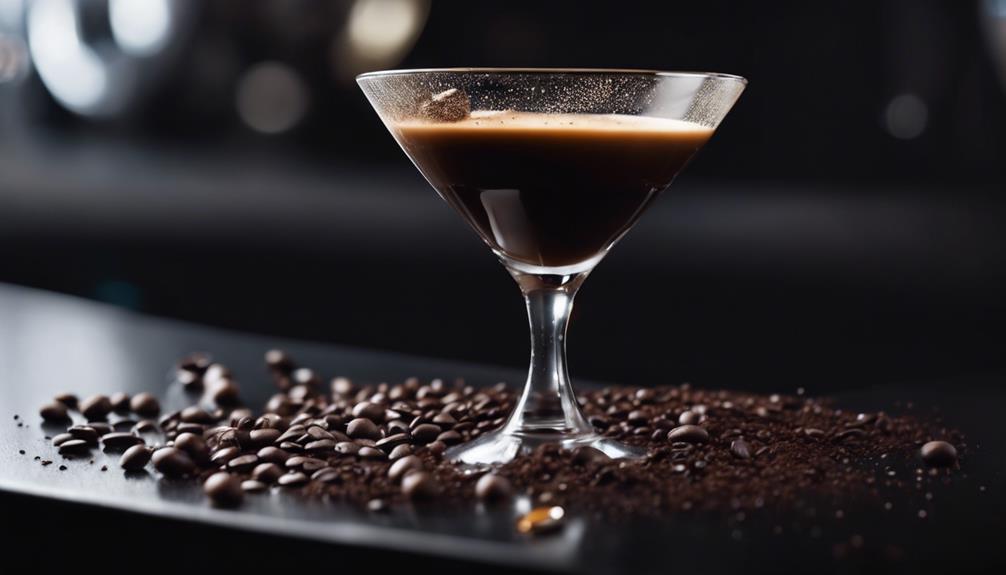To enhance the flavor of your espresso, consider running it through the machine twice. This method will enhance richness and intensity, providing a more robust coffee experience. It is important to adjust the grind size and monitor the extraction time for best results. Double extraction results in a bolder espresso with a deeper flavor profile. For optimal outcomes, try using a finer grind to intensify the taste. Experiment with various brewing ratios and savor the robust flavor slowly. For additional tips on boosting the intensity and balance of your espresso, explore the benefits and processes further available.
Key Takeaways
- Double extraction intensifies flavor and richness.
- Adjust grind size for enhanced depth of flavors.
- Experiment with longer extraction times for bolder coffee.
- Use fresh, high-quality beans for optimal taste.
- Sip slowly to savor the robust espresso experience.
Benefits of Double Espresso Extraction
To intensify the flavor of your espresso, consider the benefits of double espresso extraction. By using a double shot method, where the espresso is run through the machine twice, you can enhance the richness and intensity of your coffee experience.
This process results in a bolder espresso with a more pronounced coffee flavor, providing a more robust and satisfying taste profile. Double extraction is favored by those who seek a stronger and more intense coffee experience, as it allows the flavors to be more concentrated and impactful.
The double shot technique can elevate your espresso enjoyment by bringing out nuanced notes and enhancing the overall taste sensation. Whether you prefer a more robust kick in your morning cup or enjoy savoring the complexities of espresso flavor profiles, double extraction offers a way to customize and intensify your coffee experience according to your preferences.
Equipment Needed for Double Extraction

Consider having the necessary equipment ready for double espresso extraction to guarantee a smooth and successful process. For a double extraction, make sure you have an espresso machine equipped with a double extraction option.
Additionally, a quality grinder is essential to adjust the grind size finer for the second extraction, enhancing the flavor profile. Using a bottomless portafilter allows visual monitoring of the extraction process, ensuring accuracy.
Before starting the second run, prepare a clean portafilter and group head to maintain consistency in the extraction. Having a scale on hand is essential to measure the coffee accurately for each extraction, aiding in achieving the desired strength and flavor.
Step-by-Step Double Extraction Process

To begin the double extraction process, run your espresso through the machine a second time for a more robust flavor. This method enhances the intensity of the shot, resulting in a bolder taste profile and higher caffeine content.
Adjusting grind size and shot timing may be necessary to perfect the double extraction technique.
Double Extraction Benefits
Running espresso through the machine twice can greatly enhance the intensity and richness of the coffee flavor. Double extraction, also known as the second pull, involves extracting additional compounds to create a bolder taste profile. This process not only increases the coffee's strength but also elevates its overall complexity, catering to those who prefer a robust coffee experience.
To achieve best results during double extraction, it's essential to monitor the extraction time carefully and adjust the grind size accordingly. By experimenting with double extraction, you may uncover unique flavor profiles and discover new preferences in your espresso. This method can lead to a more pronounced flavor and a higher caffeine content in your cup, offering a heightened coffee experience for those seeking a stronger brew.
Double extraction benefits not only enhance the taste but also provide an opportunity for coffee enthusiasts to explore and tailor their espresso to suit their individual preferences.
Increased Flavor Intensity
Enhance the intensity of your espresso's flavor by running it through the machine twice for a stronger taste experience.
This double extraction method involves pulling a shot of espresso using the coffee grounds, then repeating the process with the same grounds to extract more flavor compounds.
By opting for double extraction, you can achieve a bolder and more robust espresso with increased depth of flavor. Coffee enthusiasts often prefer this technique as it intensifies the overall coffee experience, elevating the taste profile of each shot.
Experimenting with double extraction allows you to fine-tune the flavor of your espresso shots, creating a customized brew that suits your preferences.
Through this process, you can extract a richer and more complex flavor from the coffee grounds, resulting in a heightened sensory experience with every sip of your espresso.
Double extraction is a simple yet effective way to enhance the flavor intensity of your espresso shots.
Brewing Process Tweaks
For a step-by-step guide on the double extraction process, start by brewing a regular shot of espresso using your preferred method and equipment. Once you've brewed the first shot, don't discard the coffee grounds just yet.
Instead, run the same grounds through the espresso machine again to extract a stronger flavor in what's known as the double extraction method. To guarantee a balanced taste and prevent bitterness, make adjustments to the grind size and shot timing during this process.
Experiment with various coffee beans and roast profiles to discover the ideal combination for double brewing that suits your taste preferences. It's crucial to closely monitor the extraction process throughout to control the flavor intensity and prevent over-extraction, which can lead to undesirable flavors.
Adjusting Grind Size for Double Extraction

To intensify the flavor profile of your double-extracted espresso, consider adjusting the grind size for a finer setting.
When aiming for a stronger taste experience through double extraction, opting for a finer grind can be pivotal. The process of double extraction benefits greatly from a finer grind due to the increased extraction of compounds from the coffee grounds.
By reducing the particle size with a finer grind, you allow for a more extended extraction time, which enhances the depth of flavors in your espresso.
Experimenting with a finer grind setting not only intensifies the taste profile but also contributes to a bolder coffee experience, especially when running espresso through twice.
Fine-tuning your grinder to a finer setting is essential for optimizing the extraction process and achieving a robust flavor in double-brewed espresso.
Tips for Enhancing Flavor Intensity

To enhance the flavor intensity of your double-brewed espresso, consider adjusting the grind size to a finer setting and extending the extraction time.
Monitoring shot timing and extraction ratios diligently is key to achieving a robust flavor profile.
Experimenting with different coffee beans and ensuring consistent tamping pressure can further elevate the depth and richness of your double-brewed espresso.
Double Espresso Brewing
Enhance the intensity of your espresso's flavor by running it through the machine twice, a method known as double brewing. Double brewing can make your espresso taste stronger and bolder, perfect for those seeking a more robust coffee experience.
This technique allows for the extraction of additional oils and compounds, resulting in a richer and more flavorful cup of espresso. By experimenting with double brewing, you have the opportunity to customize your espresso to match your specific taste preferences.
Whether you enjoy a bold and intense coffee flavor or simply want to explore different brewing methods, double brewing is a great way to elevate your espresso experience. Give it a try and see how this method can enhance the depth and complexity of your favorite espresso drinks.
Double brewing is a simple yet effective way to take your coffee game to the next level.
Flavor Boosting Techniques
For a stronger and more intense flavor in your espresso, consider adjusting the grind to a finer setting. This can help extract more flavor compounds from the coffee grounds, resulting in a richer taste.
Additionally, here are three tips to enhance the flavor intensity of your coffee:
- Use the Essential Amount of Coffee: The amount of coffee you use plays an essential role in flavor extraction. Experiment with different coffee-to-water ratios to find the perfect balance that suits your taste preferences.
- Opt for French Press Brewing: French press brewing allows for longer steeping times, which can lead to a fuller-bodied and more flavorful cup of coffee. This method helps in extracting more oils and flavors from the coffee grounds, enhancing the overall taste.
- Invest in Fresh, High-Quality Beans: Using fresh, high-quality coffee beans is necessary for maximizing flavor intensity. Opt for beans that are freshly roasted and grind them just before brewing to preserve their flavors and aromas.
Enhancing Coffee Intensity
Adjusting the grind size to a finer setting can greatly enhance the intensity of your coffee's flavor profile. By grinding the coffee beans finer, you increase the surface area available for extraction, resulting in a richer and more robust flavor. Experiment with longer extraction times using a finer grind to achieve deeper and more pronounced flavors in your coffee. Additionally, using a French press, which allows for better extraction without filters, can intensify the flavor profile of your brew.
To further enhance the intensity of your coffee, try pulling different brewing ratios and adjusting the grind settings accordingly. This experimentation can help you find the perfect balance to optimize the flavor intensity to your liking.
Keep an eye on the bitterness of your coffee as it can be a sign of over-extraction, which may result in an unbalanced flavor. By monitoring this aspect, you can secure a well-rounded and intense coffee experience.
Experiment, taste, and adjust until you find the ideal flavor intensity that suits your preferences.
Serving and Enjoying Double Espresso

To savor the full-bodied intensity of a double espresso, consider enjoying it as a standalone beverage or as a base for your favorite coffee creations.
When it comes to serving and enjoying double espresso, here are some tips for a delightful experience:
- Sip Slowly: Take small sips of your double espresso to fully appreciate its robust flavor profile and intense aroma.
- Pairing Options: Pair your double espresso with a small sweet treat like a piece of dark chocolate to complement its strong taste.
- Temperature Matters: Double espresso is best enjoyed immediately after brewing while it's still hot to preserve its bold flavor and rich crema.
Frequently Asked Questions
Can I Run Espresso Through Twice?
Yes, you can run espresso through twice, but it may lead to over-extraction and a bitter taste due to extracting most oils and flavors in the first pass.
Professional settings avoid this practice due to flavor degradation. Instead, adjust grind size for a stronger shot without double brewing.
Experimenting with extraction techniques and grind settings can help achieve desired flavor intensity without the need to run espresso through twice.
How Do You Extract More Flavor From Espresso?
To extract more flavor from espresso, you can adjust the grind size, use freshly roasted beans, and guarantee proper extraction time.
Experiment with different brewing methods like French press or pour-over to enhance taste.
Double brewing espresso by running it through the machine twice can intensify the richness. This method is favored by coffee enthusiasts looking for a bolder flavor profile.
Try various techniques to find the perfect balance for your desired taste.
Does Brewing Coffee Twice Make It Stronger?
Brewing coffee twice can indeed make it stronger. This process extracts more compounds and oils from the grounds, intensifying the flavor. It also boosts caffeine content, giving you a more potent kick.
Is Double Espresso Twice as Strong?
Double espresso doesn't necessarily have twice the strength of caffeine content, but it can offer a more intense flavor profile due to prolonged extraction.
Factors such as grind size, water temperature, and extraction time influence its potency.
Double-brewed espresso may result in a bolder taste with enhanced flavors.
Experimenting with double brewing can cater to individual preferences, enhancing the richness and depth of the espresso for a more robust experience.
Does Running Espresso Through Twice Produce a Stronger Flavor?
Running espresso through twice does not necessarily produce a stronger flavor. However, mastering long espresso extraction times can lead to a more intense and robust coffee flavor. By allowing the water to extract more flavors from the coffee grounds, you can achieve a bolder and more concentrated espresso.
Is Running Espresso Through Twice the Same as Adding an Extra Shot to Your Coffee?
Running espresso through twice can intensify the flavor, but adding an extra shot to your coffee may not have the same effect. When making an extra shot espresso iced coffee, the method of extraction can significantly impact the taste and caffeine content. It’s important to consider the balance of flavors and strength desired.
Conclusion
To sum up, running espresso through twice can be compared to discovering a hidden treasure chest of flavor. By extracting the coffee grounds a second time, you're able to enhance the rich and bold taste that espresso is known for.
With the right equipment and technique, you can elevate your coffee experience to new heights. So go ahead, double up on your extraction and savor every sip of your perfectly brewed double espresso.









